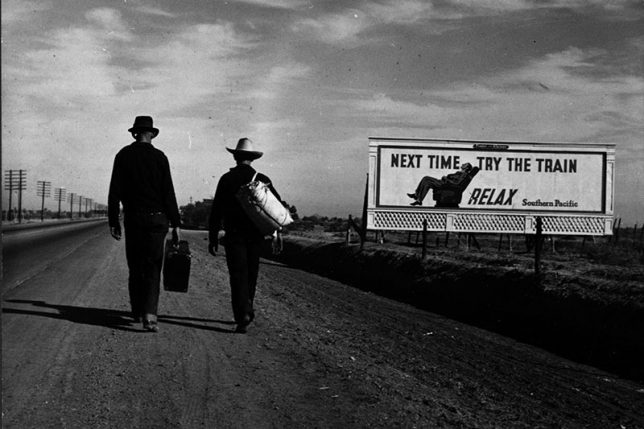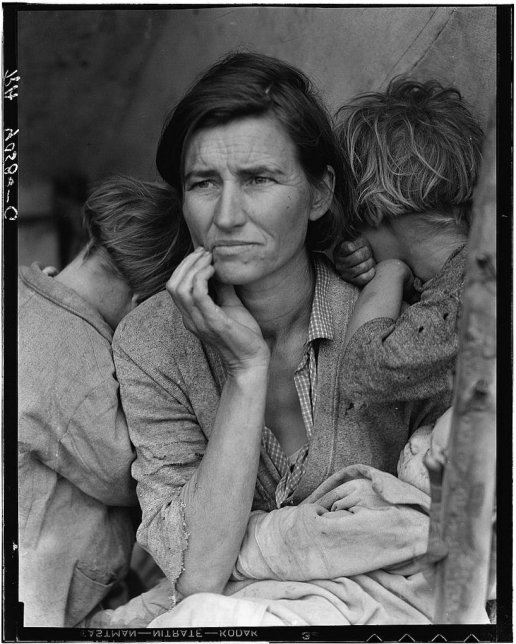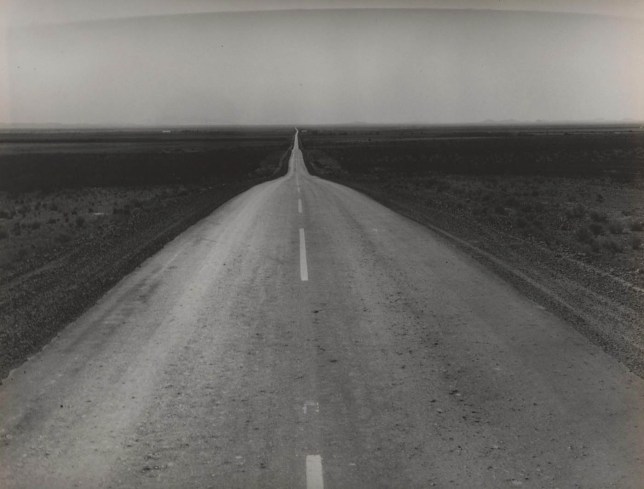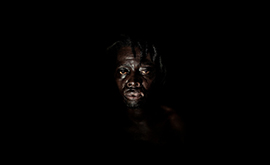
7 Dorothea Lange Images You Should Know

A studio photographer for about 15 years, Dorothea Lange was first recognized for her talent by her authentic portraits. But in 1930, the Great Depression changed her life and she lost her job. Lange then decided to go out and photograph the street and people in precarious situations. Determined and humanistic, she would become one of the most famous committed artists of the 20th century. To discover her work, here are 7 famous Dorothea Lange photos to know!
1. White Angel Breadline, one of Dorothea Lange’s first street photos

In the early 1930s, Dorothea Lange began to capture street scenes in the middle of San Francisco. The social unrest is palpable, between growing poverty and numerous demonstrations. The portrait White Angel Breadline is one of the first pictures with a social purpose taken by Dorothea Lange. It is now famous because it shows the dramatic consequences of the depression.
2. Migrant workers on a California road, between uncertainty and hope

Both documentary and cinematographic, this image represents the American paradox of that time. Two men, bundles and suitcases in hand, leave to look for work, wherever they can find it. As if laughing in their faces, we see a billboard advertising the merits of the train and its incredible comfort. This photograph attests to this era, full of doubt but not without hope.
3. Migrant Mother, the most iconic of Dorothea Lange’s photos

Can we talk about Dorothea Lange’s photos without mentioning Migrant Mother? Can we even talk about photojournalism without mentioning this portrait? Living in a camp inhabited by more than 2,500 migrants, Florence Owens Thompson is 32 years old and has 7 children to feed. Her weather-beaten features and her worried expression translate the extreme distress of mere survival. Using photography as evidence and as a weapon of denunciation, Dorothea Lange made this terrible poverty visible. A true 20th century Madonna, Florence Thompson embodies the strength and disarray of America in peril.
4. The children of the African-American farm, the anti-racist struggle in Dorothea Lange’s photos

Dorothea Lange’s social convictions were not limited to the white population of the United States. Throughout her career she also photographed African Americans through an anti-racist lens. This image is a testament to that, as it attempts to document the extreme precariousness in which the Black population lived. Regardless of the people photographed, Dorothea Lange always mixed a strong empathy with a stark reality. This invariable technical treatment testifies to an egalitarian approach. Lange wanted all individuals to have the same rights to dignity and happiness. A humanist view not shared by those who controlled the media, resulting in many of her images being censored.
5. Family walking on the highway, a concrete testimony of migration

Between 1935 and 1941, Dorothea Lange’s work is a detailed account of migration. Along with economist and sociologist Paul Schuster Taylor, Lange immortalized the plight of migrants in rural California. The combination of Taylor’s writings and Lange’s photographs would have a concrete impact on the population. Among other things, it triggered the construction of housing camps for migrant farm workers. Among Dorothea Lange’s photographs, this Family Walking on the Highway deals with the exodus in a frontal way. The bodies are in motion, the whole family is literally migrating.
6. Road West Us, an allegory of American migration

Emblematic of Dorothea Lange’s work, this photo stands out from the others, because at first glance it is a simple landscape. Yet this sea of asphalt is a perfect metaphor for American migration. A central vanishing line stretches as far as the eye can see, as if infinite. All around, the desert and the drought illustrates how long and hostile the road to nowhere actually is.
7. Japanese children wearing identification tags, a fight to defend Japanese deportees

In March 1942, during World War II, more than 120,000 Japanese Americans were interned in concentration camps in remote areas. The climate was harsh and the living conditions very difficult. Lange’s captured images that were considered so shocking that they were banned by the U.S. government for a long time. Classified in the military archives, these portraits were only made public in 2006. This photograph is one of many taken by Dorothea Lange during this period. She denounces the dehumanization of the census, showing two children with frightened faces, each wearing identification tags.
Dorothea Lange’s photos: A life dedicated to defending the rights of minorities
Whether it was migrants, African Americans, women, or Japanese Americans, Lange dedicated her life to minorities. Above all, she was a mediator, giving voice – through images – to all those who were not able to be heard. If Dorothea Lange was undeniably a talented artist, what is most impressive is the concrete social impact of her photographs. Thanks to her determination and the political context, her committed work really helped people face the reality of life in a struggling America.

About Artsper
Founded in 2013, Artsper is an online marketplace for contemporary art. Partnering with 1,800 professional art galleries around the world, it makes discovering and acquiring art accessible to all.
Learn more













